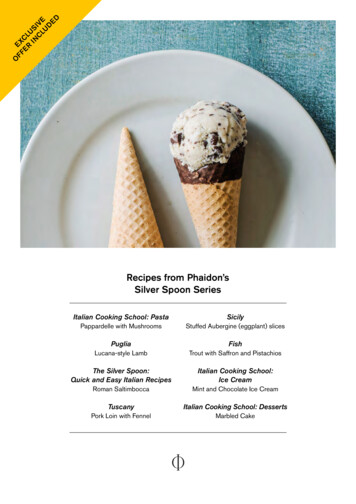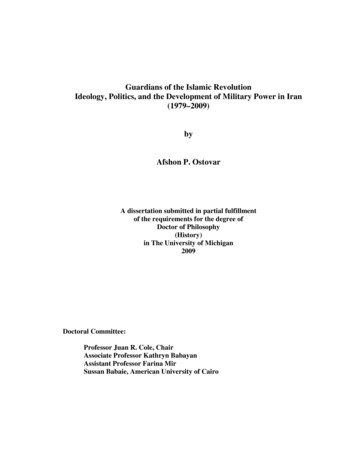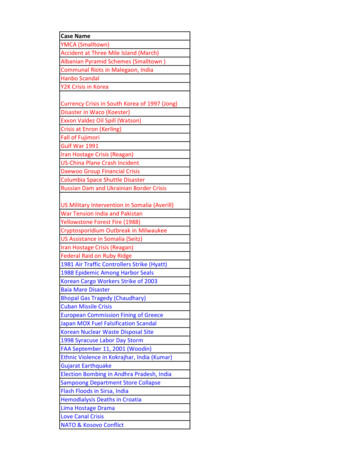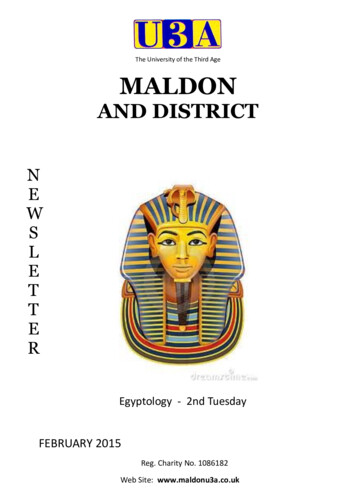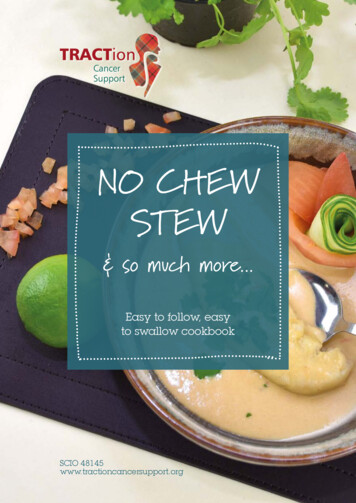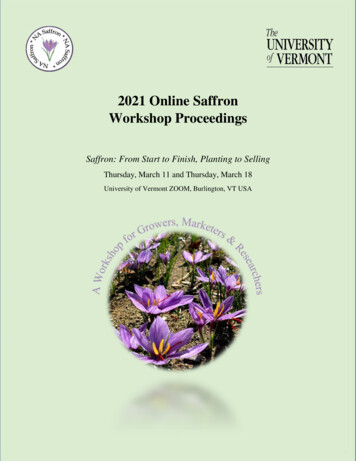
Transcription
North American Center for Saffron Research & Development2021 Online Workshop Proceedings2021Online SaffronSaffron: From Start to FinishWorkshopPlantingProceedingsto SellingSaffron: From Start to Finish, Planting to SellingThursday, March 11 and Thursday, March 18University of Vermont ZOOM, Burlington, VT USA1
Supporters of the Fifth Annual Saffron WorkshopBurlington, Vermont USAMarch 11 and 18, 2021AcknowledgementsWe would like to acknowledge the following organizations for their support of the Fifth Annual SaffronWorkshop: University of Vermont College of Agriculture & Life Sciences, University of VermontExtension System, USDA Hatch Program; and the Vermont Agency of Agriculture, Food & MarketsSpecialty Crops Block GrantCollege of Agriculture & Life SciencesAMERICAN HERBAL PRODUCTSASSOCIATIONCommunity Development & Applied EconomicsSaffronGolden Thread FarmVermont SaffronUVM Extension: Cultivating Healthy CommunitiesUniv. of VT Extension and USDA cooperating offer education and employment to everyone without regard to race, color,national origin, gender, religion, age, disability, political beliefs, sexual orientation, and marital or familial status. Resultsreported here in are solely the responsibility of the authors and do not necessarily represent the official views of the USDA2or other supporting organizations.
Table of ContentsToward Paper-based Nanocage Sensors for Saffron Analysis . 1Saffron Product Safety for Medicinal Applications . 3Weed Management in Saffron . 6Altenburger Safran 8Winter Injury of Saffron at Cobble Creek Nursery . . 10Calabash Gardens . . 12Garlic Company of Vermont: VT Grown Saffron . 14Roco Saffron 15Peace and Plenty Farm . 16Vermont Produce Program . 19Made in Wherever . 21Lemonfair Saffron 23Saffron Disease Management: Beware What Lies Beneath . 25Geographical Classification of Saffron Samples by UV-vis Spectraof Aqueous Extracts Combined with Linear Discriminant Analysis . 28Evaluation of the Effect of Dehydration Methods on the Quality of Vermont Grown Saffron 29Citation: Margaret Skinner, Cheryl Frank Sullivan, Erin White, Bruce L. Parker and ArashGhalehgolabbehbahani (Eds.). (2021, March 11 and 18). 2021 Online Saffron Workshop Proceedings.Saffron: From Start to Finish, Planting to Selling, Burlington,VT, USA. DOI: 10.6084/m9.figshare.148289823
Toward Paper-based Nanocage Sensors for Saffron AnalysisSeverin T. Schneebeli, Margaret Skinner, Jianing Li,Arash Ghalehgolabbehbahani, Olav VestrheimUniversity of Vermont, Departments of Chemistry and Plant and Soil Science,82 University Place, Burlington, VT 05405, USAEmail: severin.schneebeli@uvm.eduPhone: 1 (802)-656-0252Summary. Despite an excellent reputation of Vermont for producing high-quality food products, new realtime sensing technology is needed to ensure the highest quality of local food products. To address thisfundamental challenge, we have invented chemically tunable nanocages (molecular structures with a largecavity to bind guest molecules), which are advancing into accessible chemical sensors to detect componentslike picrocrocin in Saffron.Our nanocages are more stable and cost-effective to create than potential alternatives and they are alsocapable of cooperatively binding multiple analytes (Fig. 1) at the same time (which enhances sensitivity).For these reasons, our nanocage-based sensing technologyhas numerous potential agricultural and environmentalapplications. Proof-of-principle has been established bysensing an herbal glycoside (picrocrocin) from saffron.Fig. 1. Picrocrocin molecule (responsible forOverall, our nanocages represent (see: Sharafi et al. “Size-saffron flavor) binding inside of our nanocageselective Catalytic Polymer Acylation with a MolecularTet-1. A computer-simulated binding model isTetrahedron” Chem (Cell Press) 2020, 6, 1469–1494.Highlighted in Science Daily and 20 other Newsshown in element style with picrocrocin(organic carbon, space-filling representation).Saffron flower (lower left): stigma (redthreads); stamen (yellow structure).Channels) a new type of porous material with manypotential, future applications. A typical nanocage is1
assembled by mixing a universal corner piece with a readily available linker piece. By simply changing thelinker pieces, the nanocages can be tuned to recognize specific natural compounds (like picrocrocin insaffron) with relatively high selectivity. Linkage of the corner pieces is based on a unique technology fromthe Schneebeli lab to create hydrazone bonds, rendering the first hydrozone nanocage with Td symmetry.Due to their distinctive chemical structures, these nanocages are stable in aqueous solvents, even at 80 C.The excellent stability of the cages in water, which is significantly enhanced for our systems compared torelated imine-linked cages, is important to generate the proposed sensors. We will discuss selectiverecognition by the nanocage, as well as an outlook on real-time sensor production for saffron qualityassessment.Biographical Information. Severin T. Schneebeli completed his B.S. degree at the University of Zurichin 2006 and received his Ph.D. in 2011 from Columbia University, working jointly with Prof. RonaldBreslow and Prof. Richard Friesner. As an International Institute for Nanotechnology (IIN) PostdoctoralFellow at Northwestern University with Prof. Sir Fraser Stoddart (2016 Chemistry Nobel Laureate) from2011 to 2014, Severin’s research transitioned to the synthesis and computer-aided design of hierarchicalfunctional nanomaterials. Since summer 2014, Severin has been serving as the PI of the MesosynthesisLaboratory at the University of Vermont as an Assistant Professor of Chemistry. In 2020, Severin waspromoted to Associate Professor. His current research aims to advance the field of soft materials, byinvestigating how traditional concepts of organic chemistry — like selective recognition and catalysis —can be extended to larger length scales for precision polymer synthesis. Severin is the recipient of a 2018ARO Young Investigator Award, a 2019 NSF CAREER Award, and a 2020 Thieme Chemistry JournalsAward.2
Saffron Product Safety for Medicinal ApplicationsJane M. WilsonAmerican Herbal Products Association8630 Fenton Street, Suite 918, Silver Spring, MD 20910Email: jwilson@ahpa.orgWebsite: www.ahpa.orgSummary. In addition to being a widely used culinary spice, saffron (Crocus sativus L.) has a long historyof use as a medicinal herb. In Ayurveda, the traditional medicine system of the Indian subcontinent, saffronis called kumkuma or kesar and is used as a digestive aid and anti-inflammatory, and to treat skin conditions.In Traditional Chinese Medicine, saffron is called fan hong hua and is used to treat high fevers and increasecontractions in pregnant women. Like most traditional medicine uses of plants, a lack of contemporaryscientific research and clinical trials prevents the use of herbs like saffron from being recognized as safefor use in the treatment of specific medical conditions. The last few years has seen an abundance of newscientific information about the use of saffron and its constituents for a range of diverse medicalapplications, much of it generated by Iranian researchers.The determination of the safety of a botanical for ingestion by humans considers numerous factors. One ofthe key factors is the chemical constituents produced naturally by the plants and their pharmacologicaleffects, and whether any of them are toxic to humans. Sometimes the presence of toxic constituents isassociated only with specific parts of a plant, so that careful plant collection and processing allow for safeuse of the botanical. Another aspect is whether the plant’s constituents interact with other substances, suchas foods, dietary supplements, or medications that an individual may also consume. Such interactions mayeither slow or increase the metabolism of other medications and be potentially harmful to the individual.3
Consideration is also given to whether specific sensitive sub-populations should not consume an herb intherapeutic amounts, such as pregnant women or children.Individual countries determine the regulatory process for recognizing substances as medicinal products. Inthe United States, the Food and Drug Administration (FDA) has provided guidance on the development ofdrugs from botanical sources. In addition to the applicable regulations for conventional drug development,sponsors and investigators for botanical drugs be must able to produce an article that is exactly the samefrom batch-to-batch, so that therapeutic consistency can be assured using Chemistry, Manufacturing, andControls (CMC) for drugs generally. Few botanical drugs have been registered in the U.S., but herbalproducts and extracts are widely available in the dietary supplement product category, which has its ownunique regulatory framework.The American Herbal Products Association (AHPA) published the Botanical Safety Handbook 2ed. in 2013.This reference book of safety information for more than 500 herbs is available in both hard copy and online formats. AHPA is presently updating individual botanical entries for the on-line version, and recentlycompleted a revision of the saffron entry after review of clinical trials and other scientific studies publishedafter 2013. Saffron was classified as an herb that should not be taken by pregnant women at therapeuticdoses unless under the supervision of a qualified health practitioner, and was noted as having no knownconcerns for interactions with other substances.To summarize the new safety data available for saffron, AHPA identified more than 30 human clinical trialsthat have been performed using saffron, saffron extracts, or purified constituents from saffron, includingsafranal and crocin (Fig 1). Clinical studies were performed for a myriad of medical conditions, includingdepression, anxiety, and other mental health conditions; Alzheimer’s disease; weight loss; maculardegeneration; and rheumatoid arthritis. Most of these studies indicated some encouraging potential medicalbenefits from the use of the saffron or saffron derivatives. From a safety perspective, no serious adverseevents were attributed to the treatment of trial subjects with articles derived from saffron.4
Case reports of individual adverse events associated withingestion of saffron indicated two events in which individualshad allergic reactions after consuming foods containingsaffron. Isolated incidents such as these do not impact theoverall safety profile for saffron, particularly given its wideuse as a culinary spice worldwide.Fig 1. Chemical structure of safranal,crocin and crocetin.Other new scientific data include pharmacology studieswhich indicate that saffron may impact fasting blood glucose levels, which is relevant to diabeticindividuals. Another study examined the use of saffron in the induction of labor in full-term pregnancy.New toxicity studies ranged from measurements of acute toxicity after single exposures to assessments ofsub-chronic toxicity after exposures of three months duration in experimental animals. Data fromgenotoxicity and mutagenicity studies indicate that saffron does not cause damage to genetic material.In summary, review of new scientific data did not change the current AHPA Botanical Safety Handbookclassifications for saffron in terms of its cumulative safety and potential interactions, but the recent studiesserve to elaborate on the established safety parameters for human use of saffron. The new data contributeto a very robust profile of safety data in which traditional herbal practitioners, medical professionals,researchers, and consumers can have confidence.Biographical Information. Jane M. Wilson is the Director of Program Development for the AmericanHerbal Products Association, a position she has held for eight years. Her duties include working with theAHPA management team to develop, implement, and manage AHPA programs and services, andperforming outreach activities in support of the AHPA membership and other herbal products industryorganizational collaborators. She holds a Master of Public Health degree in Toxicology and a Bachelor ofScience degree in Medical Technology, both earned at the University of Michigan.5
Weed Management in SaffronMustapha HaidarAmerican University of Beirut, Lebanon, Department of Agriculture,Faculty of Agriculture and Food SciencesEmail: mhaidar@aub.edu.lbSummary. Management of weeds remains challenging for saffron producers in Lebanon. Saffron is arelatively poor competitor with weeds. Thus, weed control early in the growing season or before saffronemergence is a must. The only tool used against weeds by Lebanese farmers is hand weeding during thegrowing season, which is labor-intensive and economically unfeasible. Thus, the search for more effectiveand realistic methods for controlling weeds has become increasingly important. A field trial was performedin the Summer/Fall of 2017 at the American University of Beirut in Lebanon to evaluate the efficacy ofvarious weed control measures in a 5-year old saffron field. Treatments were: metribuzin (0.56 kg ai/ha,Early-POST); trifluralin (1 kg ai/ha, shallow PPI); glyphosate (3.7 kg ai/ha, Early-POST); vetch (300 kg/ha,cover crop); and check (Fig 1). Except forvetch (Planted in early August), alltreatments were applied in early-September,three weeks after irrigating the field butABCDbefore saffron emergence. Results showedthat all treatments significantly reduced thelevel of weed infestation in saffron 40 and 60days post-application as compared to thecontrol (Fig. 2). Although vetch reducedweeds,itinterferedwithharvestingFig 1. A) Control, B) glyphosate (left) and vetch (right), C)metribuzin, and D) trifluralin field treatments.operations since vetch plants were taller than6
the saffron crop, making flower pickingAverage number ifficult. None of the treatments weretoxic to saffron plants. The best 80Vetchmanagement and selectivity in saffronwere obtained by the application ofDays after applicationmetribuzin and trifluralin.Fig 2. Effect of glyphosate, metribuzin, trifluralin and vetch onweed population (n 4).Biographical information. Dr. Mustapha Haidar is a Weed Science Professor and Director of theAdvanced Research Enabling Communities at the American University of Beirut (AUB). He obtained hisB.Sc degree in plant protection from Baghdad University, M.Sc from AUB in plant protection, and Ph.Din Weed Science from Colorado State University, USA. He served throughout the years as a Chairman ofthe Agriculture Department and as a Member and Chairman of several committees at AUB and at thenational level. Dr. Haidar has more than 35 years of experience in weed management, crop production andoutreach activities in Lebanon and the MENA region and is the author of various scholarly publications7
Altenburger SafranFrank Spieth and Andrea WagnerGeraer Straße 55, Altenburg DEEmail: info@altenburger-safran.deWebsite: safran-macht-glücklich.deSummary. At our project Altenburger Safran we make it possible to combine research and community- itis a research project, but it is a communication bridge between cultures, generations and countriestoo. Currently, 128 plots (8m2 each) with different test conditions are being tested in and around Altenburgon four different areas (Fig 1). The test series take about three years with four repetitions each, for examplewith the use of fungicides and herbicides or cultivation with combination fruits.Thirty, forty, even forty-six pounds ofhighly expensive saffron are mentioned onthe chef's annual grocery list. These orderswere placed by the Altenburg castle of thePrince Elector of Saxony-Altenburg. Whyhad so much saffron ordered? We especiallyFig. 1. Test site for saffron cultivation trials inAlternburg.ask ourselves: who ordered and bought itand for what purpose? These questions lead to an interdisciplinary research project which connects to thecultural and agricultural history of the central German states of Saxony, Thuringia and Saxony-Anhalt.Until today, in the scientific literature there is hardly any evidence of research on saffron for these regions.Yet, the issue appears to be worthwhile of further investigation. From previous research, which is basedexclusively on the study of original files in the historical city and state archives in Altenburg, Weimar andDresden, it becomes clear that saffron was part of the exotic spices used in the kitchens of the nobility at8
the beginning of the 15th century. Saffron had even found its way into the bourgeois kitchens of some cities.Apparently the large quantities of the spice bought by the chef were imported into Central Germany. Thetraders and the routes they used are, so far, unknown. However, by the late 15th and early 16th century at,saffron was cultivated locally in specially designed gardens in the Thuringian cities of Jena and Altenburgand sold by local saffron traders and spice dealers.Even the kitchen lists of the infamous Landsknecht mercenaries explicitly mention saffron in addition toginger and pepper. In a cookbook from a Dominican monastery in Leipzig 80 out of 130 recipes includesaffron as an important ingredient. Many of these recipes would even match today's culinary habits. In thesearch for answers to the questions asked at the beginning, not only commercial and culinary aspects are ofinterest. Even geographical names still in use today, such as Safranberg (Saffron Hill) or Safrangarten(Saffron Garden), point to this highly interesting chapter in late medieval cultural history.Biographical Information. Dr. Frank Spieth was born in 1962 in Kahla, Thuringia. He studied agricultureat the University of Leipzig before receiving a doctorate in economics in 1993. From this time through2015, he worked as an advisor on fundraising for several non-profit organizations. In 2015, he co-foundedthe non-profit company “Wandel-Werte-Wege – W3”. He has served as project manager for research on there-cultivation of saffron in Germany since 2016, with a focus on planting, harvest and economy.Andrea Wagner was born in 1969 in Erfurt, Thuringia. She studied German, Slavic and educational sciencesin Erfurt, Jena, Berlin and Kaluga from 1987 to 1995. For the next 20 years, she worked as an auditor forcertification of companies with a focus on employment of women and work-life balance. In 2015, she cofounded the non-profit company “Wandel-Werte-Wege – W3” and has served as the owner and CEO since.Her main focus is saffron in history, literature and daily life.9
Winter Injury of Saffron at Cobble Creek NurseryJohn PaduaCobble Creek Nursery LLC, 991 Tyler Bridge Rd, Bristol, VT 05443E-mail: cobcreek@gmavt.netSummary. Cobble Creek Nursery is a wholesale grower of trees and shrubs in Monkton, VT, establishedin 1986. We are located in USDA hardiness zone 4 (average winter lows of -15 to -30 F). We decided totry saffron in 2017 and planted 2500 corms from ROCO in Holland in late August, 2017. We planted twoslightly raised beds about 120 feet long. The beds were 3 feet wide with the corms planted 6 inches deepand 6 inches apart in staggered rows (Fig. 1). The first fall our harvest only yielded a disappointing 150flowers.The second harvest in the fall of 2018 was a bountiful 65 grams (10,000 flowers). Our fall 2019 harvest was even better at about 80 grams eventhough the season was shortened in November with a below normal coldsnap. November 8th saw 3 inches of snow, November 11 and 12 a fewmore inches. Then we had a low of 3 degrees Fahrenheit on the morningof the 13th and similar lows on the 14th. At this time there was still 3-5inches of snow covering the saffron beds that insulated the ground, cormsand lower saffron foliage. However, the top halves of the leaves wereexposed to the cold. We then experienced even colder temperatures onNovember 16 and 17, slightly above and below zero. The damage wasFig. 1. One of two 120’ saffronbeds at Cobble Creek Nurserydisplaying senescence of theleaves.not visible to the eye right away but showed up later. In late winterand early spring the portion of the leaves that were unprotected above the snow had turned a brownish tancolor. The foliage below the snow was green. I remember from a previous conference that saffron is cold10
hardy to around -15 F. However, most plants reach their peak winter hardiness in mid-winter. It’s a gradualhardening off that takes place in the cells of plants as the weather turns colder in fall and early winter. Iknow this from my 40 years of nursery growing and from research that Dr. Norman Pellett did at UVM.I also contacted Dr. Leonard Perry form UVM who did similar research on herbaceous perennials. Heconfirmed that cold hardiness in plants increases and peaks by mid-winter.The foliage died back normally by early June. In September of 2020 the new foliage began to emerge andby mid-October there was lush, healthy foliage. What followed was a very disappointing harvest of about12 grams from the beds that had yielded 80 grams the previous year. We expected that maybe our yieldwould decrease a bit because it was our 4th harvest season. That may have been a small part of the reductionbut I suspect the major cause was the foliage damage and the resulting reduced photosynthesis in the winterand spring. Consequently there were far fewer flower buds that were initiated. We are hoping that the cormsrecover and give us a better yield in the fall of 2021.In conclusion, those of us that are growing Saffron in areas where winter temperatures hit -15 F or colderafter Jan 1, or get unexpected cold snaps earlier in the winter, should make plans for protection. After ourexperience from November 2019 we now use heavy grade winter blankets when needed for temporaryprotection. The blankets are made of spun bonded polypropylene similar to Remay row covers but muchthicker. If interested you can contact me for more information and sources.Biographical Information. John Padua has a BS in Plant and Soil Science from the University of Vermont,Burlington VT. He has been a grower and propagator of woody nursery plants in Vermont for 40 years.11
Calabash GardensJette Mandl-Abramson and Claudel Zaka Chery1831 Fish Pond Road, Wells River VT 05081E-mail: calabashgardens@gmail.comWebsite: www.calabashgardens.comSummary. Calabash Gardens is a saffron farm in Wells River, Vermont. They began a test plot for saffronin 2018 and continued testing for 2 years. Their initial 2,000 corms produced about 10 grams of saffron forthem in their first year. The following year, they harvested one ounce (28g) of saffron. Inspired, theyexpanded to half an acre in 2020, seeking to host 120,000 corms. Intensive rock removal was needed inorder to prep the land for planting. Once prepped, thefield was dimpled for a planting template. Thedensity of corms started at 6,000 corms, howeverthey stretched to try and meet their goal of 10,000corms per row. 70 volunteers were needed to get thework done. With necessary COVID precautions inFig 1. Field preparation for saffron planting in Fall 2020.place, volunteers worked over the course of fourdays. While most were planters, some were kitchen aids and others musicians for entertainment. 70,000 oftheir 120,000 corms were planted during this volunteer party. The last corm entered the ground September25th. At least one volunteer assisted Jette each day following the planting party, for a few hours at a time.Overall, the experience was incredibly labor intensive and time consuming; Jette worked every day for 6-8hours. Their first flower was seen on October 8th, and their last flower on December 6th. Overall, they wereharvesting every day for nearly two whole months. Their peak harvest lasted one week. Luckily, about tenfamily members had come to visit during this time. They typically had six people in the field harvesting12
from 9am to 3pm, and another 4 people inside processing. It took about twice as many hours to process asit did to harvest, and most nights they finished between midnight and 1am.This year, they will be expanding to a full acre, half of which will be in its 2nd season. Four to six new fulltime employees will be added to ensure the work is completed. Zaka notes that you need to expect a lot ofhard work. Both labor force and proper preparation are incredibly important. Jette notes that while flowerscould be held overnight, the crop will be lost on the second day. Processing needs to be done immediatelyto ensure the highest quality.Biographical Information. Jette Mandl-Abramson, born in New Mexico, raised in the South coast of NewHampshire, is primarily a ceramist, herbalist and organic regenerative farmer. She has also worked in therestaurant industry for fifteen years. Her passions are great food, horticulture, animals and wild edibleplants. She wants every initiative she takes to be ecofriendly and regenerative as well as giving somethingback to the community. She started work on a horse farm when she was 11 years old. At 26 she started herfirst organic farmstead in Lee, NH and moved the whole farm north shortly thereafter.Claudel Zaka Chery, a Haitian poet and film director, moved to Newbury from Jacmel-Haiti in 2011. Hewas the assistant to the director of FOSAJ, Flo McGarrell. Both Mr McGarrell and Zaka ran the Jacmel artcenter with great energy and taste. It’s while there in Newbury he honed his interest in peculiar taste, spices,such as saffron and cuisines. Jaka and Jetta bought a farm in Wells, VT where they specialize in saffronproduction.13
Garlic Company of Vermont: VT Grown SaffronSean Lindley265 Cassie St, Barre VT 05641E-mail: sean@garliccompanyofvermont.comSummary. The Garlic Company of Vermont is a small family farm inBarre, VT. In 2019, they purchased 1,000 non-organic saffron cormsfrom Roco Saffron. After minimal ground preparation and planting,they saw their first flower on October 11 and last flower on November3. Their first year harvest was just over 3 grams with a 70-75% bloomFig 1. 2019 saffron blooming season.rate (Fig 1).The second year, about 12,000 ft2 was preppedfor the second planting. 10,000 Roco Saffronnon-organiccormswereordered.Soilamendments consisted of compost, 1200 lbs ofTable 1. Blooming timeline and total harvest for the 2020and 2021 seasons.lime, 300 lbs Pro-Grow fertilizer, and 40 hours of rock-picking. Their first flower wasseen on October 23 and the last flower not until December 4. These newly planted corms produced about35 grams in 2020, while corms planted in 2019 produced about 30 grams in their second season. (Table 1).Biographical Information. We’re a small family farm that is located in Central Vermont, in the beautifulTown of Barre. Growing garlic began as a hobby, and over decades, has turned into a passionate missionto share our garlic with everyone. We specialize in growing the highest quality, most flavorful, hardneckgarlic. Our farm family believes that healthy plants come from healthy soil, and we use only naturallyoccurring fertilizers and amendments in this process.14
Roco SaffronHans RotteveelBulb Trade Park 3, 2211 SW NoordwijkerhoutE-mail: hans@rocosaffron.comWebsite: rocosaffron.comSummary. Roco Saffron is a family company supplying the industry with premium quality of Saffronbulbs directly from the farms in the Netherlands since 1882. It was originally founded by the Rotteveelfamily four generations ago distributing flower bulbs such as tulip and hyacinth bulbs to Europe and U.S.A.markets. With specific expertise in saffron corms, they’ve developed contracts with a number of Dutchgrowers for saffron corm production. They are able to guarantee corm sizes, starting at 7 cm to 11 cmcircumference. Corms are kept at a constant temperature from harvest until delivery with temperaturecontrolled reefer containers. This is necessary for Northern hemisphere shipments as sailing time fromRotterdam to New York is approximately 14 days. North Americangrowers can expect corm delivery between the end of August and earlySeptember. Southern hemisphere markets receive special temperaturetreated corms in climate controlled cells between February and March.Fig 1. Harvesting saffron cormswith partnered Dutch growers.Corms can be purchased online through the official Roco Saffron onlineshop.Biographical Information. Hans Rotteveel has been involved in the Flower Bulb business since a child.Hans has traveled throughout Europe & the U.S.A. visiting customers and supplying the finest quality offlower bulbs from Holland. Hans decided to fully dedicate working with professional Saffron growers fromall over the world supplying not only his expertise about Saffron but also premium quality Saffron Bulbs.Roco Saffron is a Rotteveel company with a focus and specialization in Saffron Bulbs only.15
Peace and Plenty FarmMelinda Price and Simon Avery4550 Soda Bay Road, Kelseyville California 95451E-mail: peaceplentyfarm@gmail.comWebsite: peaceplentyfarm.comSummary. Peace and Plenty are an organic, 7-acre market garden and saffron farm based in NorthernCalifornia. They also serve as an Airbnb and event space for others to enjoy. Their organic saffron fieldswere first established in 2017, where they planted 7000 corms in 6000 sq. ft. Their yield that first year wasabout 25 grams. They lost an estimated 30% of their corms to gophers and voles, leading them to dig up allremaining corms in 2018, which amounted to around 50,000 corms. These corms were then planted inapproximately 10,000 sq. ft. of rai
North American Center for Saffron Research & Development 2021 Online Workshop Proceedings . Thursday, March 11 and Thursday, March 18 University of Vermont ZOOM, Burlington, VT USA . 2 Golden Thread Farm Vermont Saffron AMERICAN HERBAL PRODUCTS ASSOCIATION College of Agriculture & Life Sciences . University of Vermont College of Agriculture .



